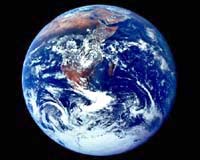
 |
The participants, which include the Group of Eight industrialized nations, the European Commission and 36 other countries, will sign a 10-year implementation plan that should help improve output by aiding the prediction of global weather patterns, disease outbreaks and energy needs.
"This is the next step forward in human productivity," Michael Leavitt, Administrator of the US Environmental Protection Agency, told reporters.
"It comes when people can take the tools that are available and work together. That's the Earth Observation Summit (EOS). The creation of a global Earth observation system of systems."
The one-day EOS ministerial meeting on Sunday follows a first gathering held in Washington in July last year, which was established by the G8 meeting held in Evian, France last June.
Its aim is to link the various observation tools such as satellites, weather balloons and human monitoring that are scattered across the globe.
Better data gathering could result in better crop planting decisions, more efficient energy output planning, and improved preparations for outbreaks of diseases such as West Nile and malaria.
But combining the systems globally remains a major technical and political challenge, Leavitt said.
"Water monitoring can be people going into streams, turning over rocks and recording the information," Leavitt said. "That happens on different continents, but if they're not looking for the same thing and putting the data into a format that can be used, it's of little value to others."
"That's the reason why a system like this takes a decade to build," he said.
The United States expects to save at least one billion dollars a year in energy costs under the plan.
It noted that a US-Japan monitoring system involving buoys in the Pacific Ocean helped trim 1.1 billion dollars in storm losses from the El Nino weather phenomenon in its state of California in 1997-98 compared to 15 years earlier.
TERRA.WIRE |